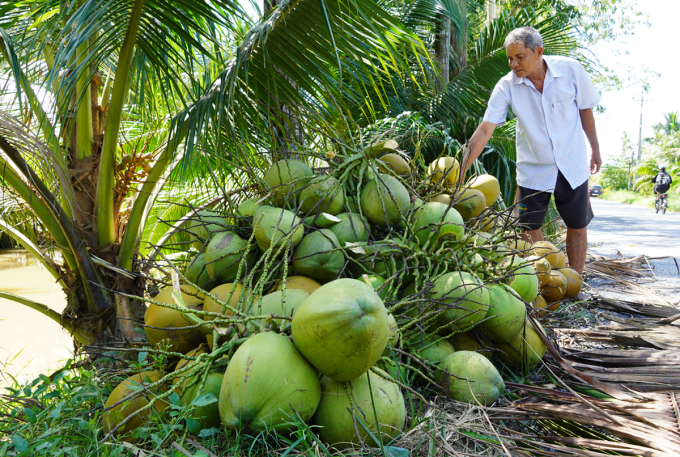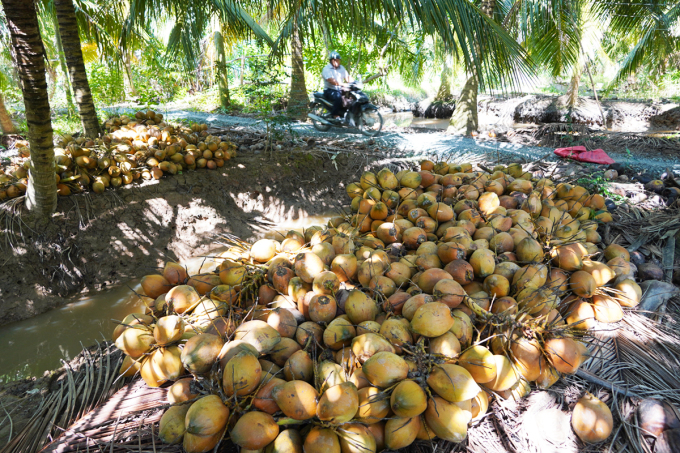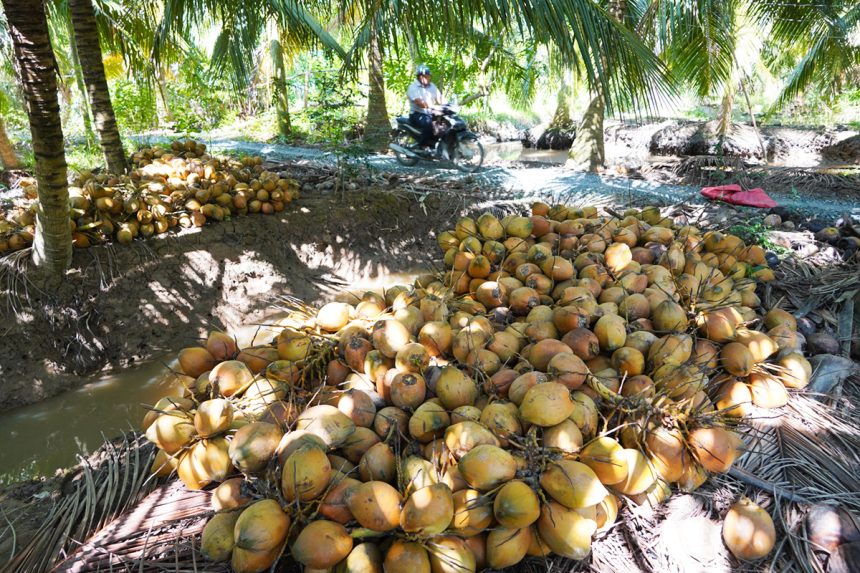Ben treDuring the main season, coconut exports in the West are “dripping”, traders only buy 1,500-2,900 VND per fruit.
Mr. Phan Van Dinh, 68 years old (Binh Thanh, Giong Trom) has a 2,000 m2 coconut garden that is more than 10 years old. After the trader came to pick them, Mr. Dinh pointed to the pile of more than 300 coconuts gathered along the road waiting to be transported and shook his head.
“Selling once a month is only about 1 million, just enough to cover the cost of fertilizer and not profitable,” the old farmer said.

Mr. Phan Van Dinh with the newly harvested coconuts, but according to him, the money collected is only enough to cover the cost of fertilizer and medicine. Image: Hoang Nam
Mr. Dinh’s family grows mulberry coconut varieties, specializing in harvesting dried fruits to press oil. During the “golden age”, dried coconuts cost about 10,000 VND per fruit, and he and many gardeners made a living. However, since the Covid-19 epidemic, the price of dried coconuts has continuously plummeted, sometimes just over 1,000 VND per fruit. He changed his “tactic” of not letting the fruit dry, switching to picking fresh coconuts to sell.
Every year during the rainy season, coconuts produce a lot of fruit, so the price is somewhat lower than at other times. In previous years, this season the lowest price of fresh coconuts was 60,000 – 70,000 VND per dozen of 12 fruits. But in recent months, Mr. Dinh said, traders only buy fresh coconuts for 30,000-35,000 VND per dozen, 2 or 3 small-sized coconuts for the same price as one fruit.
About 2 km away, the 6,000 m2 coconut garden of Mr. Le Van Trong, 53 years old, has been harvested. However, instead of traders coming to transport them, more than 2,000 fruits have been lying along the road for the past 2 weeks. Next to that, about 500 coconuts harvested in the previous round have also turned dark gray, and some have sprouted green buds.
The owner of this garden planted the original red coconut variety “Malay” about 6 years ago, and after 3 years it started to bear fruit. This coconut variety bears fruit but is smaller in size, so traders criticize it and buy it at a lower price of 10,000-20,000 VND per dozen.
In recent months, with red coconut varieties, traders only buy fresh coconuts for about 1,500 VND per fruit. The low price was unprofitable. Mr. Trong tried to hang coconuts on trees to wait for the price to increase, but to no avail. The number of coconuts in the garden was too old to sell fresh, so he had to pick them and gather them along the road to wait for the dried coconuts to be sold as seed.

More than 2,000 of Mr. Trong’s oversized fruits had to be picked and taken to the garden to wait for the dried coconuts to be sold as seed. Image: Hoang Nam
Mr. Bui Duong Thuat, Director of Mekong Fruit Import-Export Company (Chau Thanh, Ben Tre), said the company still purchases green Siamese coconuts and red Siamese coconuts, the proportion of green coconuts is slightly higher. However, no matter what variety, he said it must meet the standard of 1.4 kg-1.8 kg each fruit. Standard coconuts will be purchased by the company at a price of 70,000 VND per dozen, double the market price.
Mr. Huynh Quang Duc, Deputy Director of the Department of Agriculture and Rural Development of Ben Tre, said that it is the rainy season and coconuts are in harvest with large output, so prices have decreased somewhat according to market rules.
The agricultural industry has for many years recommended planting local green Siamese coconut varieties to ensure purchasing standards. However, currently, in about 10% of the coconut area, farmers spontaneously plant foreign varieties that do not meet standards, so output is difficult.
Like the family of Ms. Nguyen Thanh Thao (39 years old, Chau Binh, Giong Trom) has 7,000 m2 of “Malay red coconut” that has just been harvested for 2 years. 6 years ago, the price of dried coconut fell, so her family cut down the old coconut area and planted red coconut water, which was at a high price at that time, in the hope of changing their lives. Recently, red coconuts with small fruits were criticized by traders. Her family bought green coconut varieties to intercrop in the garden, planning to cut down red coconuts next year and return to traditional coconuts.
Ben Tre has over 74,000 hectares of coconut, accounting for 80% of the coconut area in the West and 50% of the country’s coconut area. In addition to relatively modest exports to the US, Ben Tre coconuts are mainly purchased by domestic traders. The largest market is China, which has come to the locality to survey growing areas and packaging facilities.
“Currently we are just waiting for the signing of protocols to officially export coconuts to China, which has a large consumption power, then the lives of coconut growers will be better,” Mr. Duc said.
Hoang Nam



